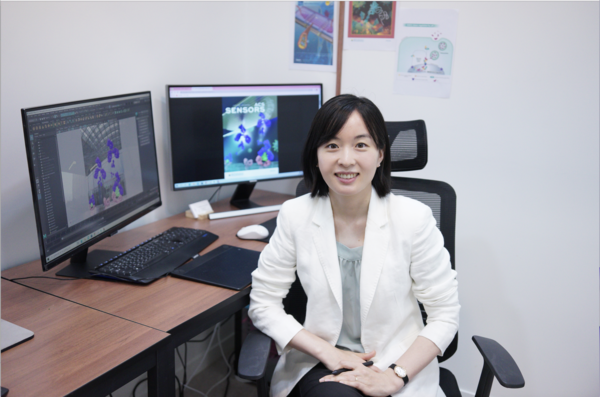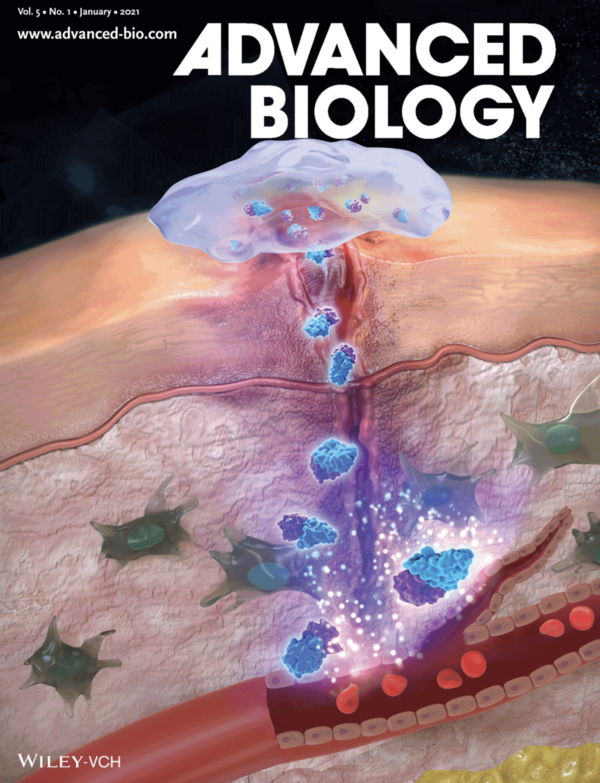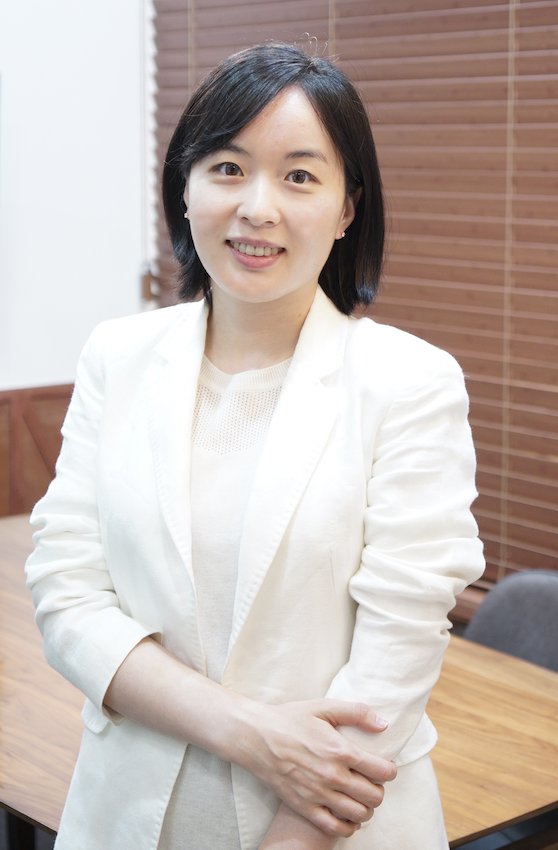
The era of the Fourth Industrial Revolution has arrived. In this era, we apply new technologies without being complacent. Biomedical art is one of the most representative occupations of the Fourth Industrial Revolution. Here's one person who's pioneering and building her own path in the changing era. SMT met Yoon Taewon, a science visual communicator, who created a new path by converging art and science.

Before we start the interview, please introduce yourself and your work to Sookmyungians.
Hi, I'm Yoon Taewon, a science visual communicator. I graduated from Sookmyung Women's University with a degree in biological sciences. I am working to realize figures and schemes of scientific, medical, and biological research and phenomena as visual materials such as illustrations and videos. I make it easy for non-majors, doctors, and patients to understand science, medicine, and biology. As a science visual communicator, I currently run a company called Bio Art Lab (BAL) and give special lectures to universities. I am also working on a project with global companies such as LG Chem, GC Pharma Corporation, and Cosmax.

For what reason did you choose this career, and what do you feel is the charm of this occupation?
After my master's degree, I worked as a researcher at Samsung Medical Center. I felt limited in my professional knowledge, so I began a doctorate at Seoul National University's College of Pharmacy. I realized that the doctoral course was a choice based on social needs and I didn't like research work. What I wanted and liked the most instinctively was art. So, based on the medical science and biological knowledge I had acquired, I finally came upon the job of a science visual communicator. The charm of this field is that the work requires more knowledge and access than just expressing facts well. This job requires high-level and professional analysis. So, it is interesting that the work has an infographic characteristic that interprets and delivers biotechnology expertise.
You must have had a vague fear of choosing a job in 'Blue Ocean', how did you overcome it?
I started this work at the end of my twenties. When I looked back on what I had achieved so far before thirty, I saw nothing. So, I was afraid that I would not be able to live my life by doing this work. I felt miserable compared to my colleagues who had gotten jobs at a large company or had gone to a medical graduate school. Also, I was frustrated with my very small income and poor treatment. At that time, all I could do was pull myself together. Then, I realized 'doing what I want to do now' was a benefit and luxury itself and could not be compared to a high salary. Finally, I believe that I wasn't too late because I would do this work for the rest of my life.
What efforts have you made to develop your own career in this profession?
I acquired 3D and 2D program skills such as Maya, Blender 3D, Cinema 4D, ZBRUSH, Substance 3D Painter, and After Effects. I registered at an art academy to study composition and human body proportions and did a lot of imitation. Currently, I am continuously learning skills to master programs by watching YouTube and Internet lectures. Despite my effort, I realize that there is a limit to learning 3D animation by myself, so I am learning about video production in depth in Chung-Ang University's doctoral program.
What difficulties did you have as a non-art major and what efforts did you make to overcome them and develop your artistic sense?
It was difficult to express the basic elements of painting such as light, shadow, and line. I learned how to express lines naturally while attending the art academy, and I visited art museums to understand colors, composition, and trends of art. I collected biomedical illustrations and video-related references online and imitated them. I think 'imitation' is the best way to improve one's skills, like transcribing novels or essays to become a writer.
You work using various program tools. Please briefly explain how the process of creating pictures and videos is carried out.
In the case of pictures and 2D, I sketch and color first in Adobe Photoshop or Illustrator. Video and 3D are added next to make a scenario. After meeting with the client, I understand the content and write a script. After that, I make a storyboard to determine the detailed camera composition and color and then create a 3D prototype with tools such as Maya and Blender 3D. Then, I consider 'light' and 'shadow' and make snapshots of the main scene in the video and share them with the client. After rendering the camera work and 3D prototype as a video, I edit the scene of the shot unit and finally complete it through work such as subtitling, sound, color, and revision.
In the process of working, what is the most important thing that you care about and why? Also, what part of the work is most difficult for you?
Exact communication is the most difficult because this work is not pure art that only requires the artist's creativity. It is important to constantly communicate with researchers to find visual elements and tools that can best reveal the results of the study. It would be a very difficult task for the researchers who commissioned the work. As we communicate via language, the concept is not clear, so this work is a series of abstract explanations and revisions. It is difficult but interesting to create satisfactory content by grasping the intention of the researcher and by presenting visual alternatives through continuous conversation.
Your profession combines science and art with a lot of skill and knowledge. What capabilities do you think are important in this field?
As with all fields of expertise, the 'learning ability' that is constantly ready to explore study is most essential. Visualization methods are expanding infinitely to 2D, 3D, and even AR and VR. Science visual communicators need to quickly learn the tools that fit each visualization approach. Patience, persistence, and diligence are the basics. And it is important to clearly communicate and actively suggest results with professionalism and sincerity to clients.

What was the most memorable or helpful activity or class you did when you were a student at SMWU?
Professor Lee Myungseok's molecular biology class is the most memorable. This is because figures in the thesis related to general biology can be expressed based on an understanding of molecular biology. With knowledge related to molecular biology, communication with researchers was easy, which was possible based on the knowledge gained in the class. Experimental lectures on molecular biology were also helpful. As a biotechnology major, I understand the method and process of experiments that many clients work on, so I can express data and communicate with clients.
A science visual communicator seems to have to constantly learn and explore due to the nature of the job that utilizes various studies. What are you studying and trying now?
To study the driving of 3D prototypes and learn how to professionally implement 3D images, I have been attending Chung-Ang University's doctoral program since 2018 as I mentioned above, and the coursework will end next semester. In addition, as the era of making personal videos comes, I am learning 3D video programs such as Unreal Engine. Personally, I am also raising my three-year-old daughter, so I am striving every day to play the role of a working mother, student, and entrepreneur.
What's your goal as a science visual communicator?
As an entrepreneur in a new field that's emerging around the world, I want to grow BAL into a reliable company. These days, investment in biological science and medical science is brisk, so this work is very promising. The methods to expand the business are endless because it is based on content production. I would like to contribute to expanding and leading the field of K-Bio Medical Graphics.
Are there any sites, books, journals, lectures, etc. that you recommend to students who want to know Biomedical Art?
I recommend the websites 'Nucleus Animation', 'XVIVO,' and 'MADMICROBE'. I also recommend the portfolio of a famous biomedical imaging company in the United States. In addition, <The Visual Story: Creating the Visual Structure of Film, TV, and Digital Media> helped me make the videos.

Lastly, please give some messages to Sookmyungians who are preparing for the 4th Industrial Revolution.
Recently, I read an interesting book called <Polymath>. It shows people with vast comprehensive thinking and methods drawing attention by showing their talents in various seemingly unrelated areas. Also, a 'new leader type' that leads society by breaking down academic boundaries and connecting academics creatively is emerging. I have never made the first achievement in biotechnology, and I've never produced a work of pure art. I think I was able to have this interview because I fused and developed my own tools and talents. Find and combine your favorite areas and talents you are good at. You'll have a super personalized weapon in this super personalized age. Isn't that what 'the New Normal' is?
YOON TAEWON
-Graduated from the Division of Biological Sciences at Sookmyung Women's University (2005~2009)
-Graduated with Master's degree from the Department of Agriculture and Biotechnology at Seoul National University (2010~2012)
-Studying Doctor's Degree in Advanced Imaging Sciences, Multimedia and Film at Chung-Ang University (2018~)
-In charge of Biomedical Visualization at Seoul National University's Bio-Convergence Research Foundation (2014~2021)
-3D Animation Instructor in Department of Biomedical Art, Incheon Catholic University (2019~2021)
- CEO of Bio Art Lab (BAL) (2019~)
Kim Seol Yunha / Culture Section editor
smt_syh@sookmyung.ac.kr
Ju Kim Jiyeong / Cub Reporter
smt_kjy@sookmyung.ac.kr


